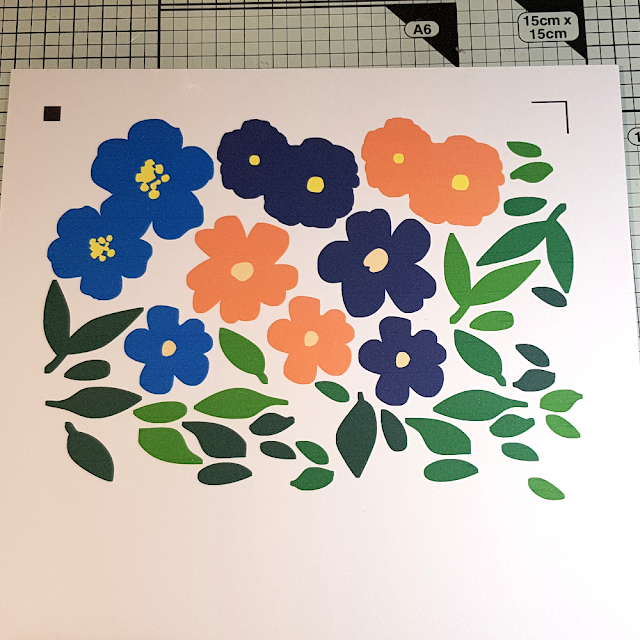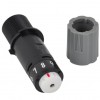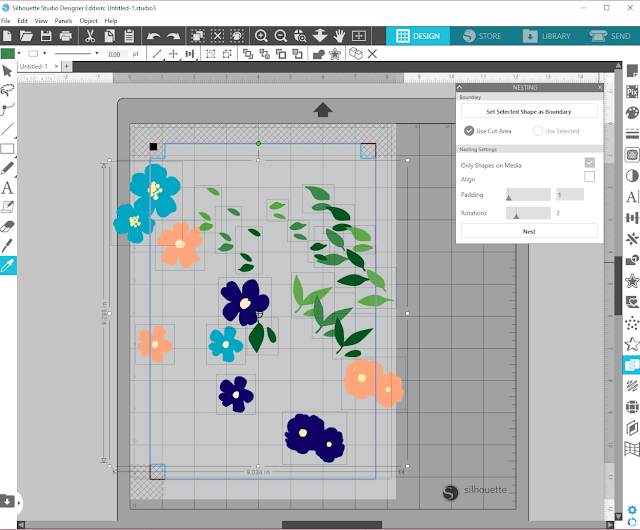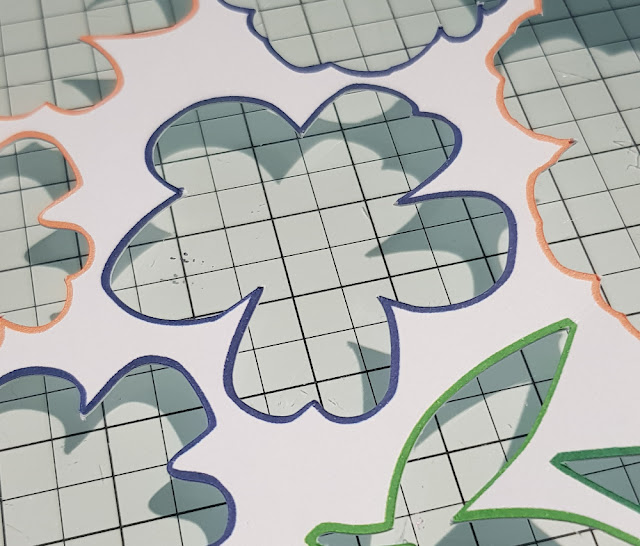Hello, it's Verity here from Pretty Little Button. For today's post, I'm going back to basics and showing you if you haven't used it already, how to use the print bleed feature in the most updated version of the software. Now you need to make sure your version of the software is 2.4 - if you don't have this, you can update here. There are a variety of different features in the new version, and it also depends on what edition of the studio you have - i.e basic, designer, designer plus, business etc. The print bleed feature should be available in the basic edition of the software. If you want to see a comparison of features in each edition of the software, head over here.
I have created three different cards with some fantastic designs from the Silhouette Store and used 3 different print bleed settings to show you the difference. The print bleed option is great if you are worried it might cut slightly misaligned. If this happens, you haven't got to worry around a white offset appearing when it shouldn't as the print bleed will print colour, further beyond the design. Therefore if it does cut misaligned, the colour of the image will still remain in that cut area and not appear white. This is a great feature if you want to cut lots of coloured die cuts and don't have many colours of cardstock. Instead, just use the print and cut feature combined with the print bleed like I have today and the possibilities are endless!
Using the 'Print bleed' for die cut printed elements process:
To start off, add a selection of floral elements from the Store and colour the items in. To save time and a reduced amount of card wasted, use the nesting feature to nest all the design pieces up within the print and cut window (remember to turn this on using the registration marks tab within the page setup window on the right-hand tool bar).
When nested, all items will be nested up near the top of the page within the print and cut area.
However, you may wish to space the design elements out slightly for the 'print bleed' area. To do this, change the padding value within the nesting window.
After pressing the 'Nest' button once more, the designs will have shift again proving slightly more space between the design elements. To add the print bleed, you need to open up the Page Setup window. Down the bottom of the window, there is the option to select 'Print bleed'. Here you can adjust the amount of bleed - the default setting is 0.050 inch.
For the florals above I used 0.020inc. When applying this, it does not alter the images within the studio - i.e it does not add the print bleed in the window for you to see.
Following the print, you may not notice much difference for this print bleed as it is very small.

As you can see, once cut there is a print bleed, albeit thin in case of any misalignment.
You can see the print bleed a little more with this setting once printed. The corners of the flags and balloons are not as sharp.
This setting has given a reasonanbly good print bleed.
For the unicorn card, I used a print bleed of 0.040inch.
It was much more obvious with this one, as some of the items are overlapping/slightly touching. Therefore this shows that if you are going to next your items, make sure you adjust the padding aree to reflect how much of a print bleed you are going to add.
This setting gave ample room should any misalignment occur.
On a side note, when you upload to the new version of the software, you get improved thumbnails of silhouette files. Prior, a Silhouette document would have the Solhouette logo for the thumbnail image, as seen below.
Following the update, the thumbnails now include an image of what the file contains. This is great if your name of the file doesn't jog your memory as to what it is, the little image will do. Also makes it much faster to find the file you are after if you are able to see the contents of it in the thumbnail.
Using the 'Print bleed' for die cut printed elements photos:
To assemble the dinosaur card, I used ink blending brush to apply yellow ink to a background. Following this, I added splatters of the ink watered down for some added interest to the background. The elements were foam mounted onto the card and some blue bakers twine added to the top of the card, to make the 'Party' banner.
For the floral card, I ink blended through a striped stencil. You can see how this stencil was made on the Silhouette Cameo, in this post here. The floral elements were foam mounted onto the card and the leaves were adhered using liquid adhesive.
A layered die cut and heat embossed sentiment was added to the card, and it was finished off with a selection of sequins.
For the unicorn card, pink ink was applied to the background with ink blending brushes and the items were layered onto the card with foam pads for added dimension along with a heat embossed sentiment.
For some added sparkle, glitter was added to the horn of the unicorn and the blue flower using a Wink of Stella brush. Laslty, the card was finished off with a selection of sequins.
If this has inspired you to try this out, please post below. I would love to see it!
Until next time,
Verity

Profile | Pretty Little Button Blog | Instagram | Facebook
DESIGNS USED:
- PARTY BANNER by Bella Blvd, Design ID# 288257
- BIRTHDAY DINO by Bella Blvd, Design ID#288455
- FLOWERS, 269216
- FLOWERS, 266746
- FLOWERS, 264648
- UNICORN by Lori Whitlock, Design ID#226554
PRODUCTS USED:

























No comments:
Post a Comment